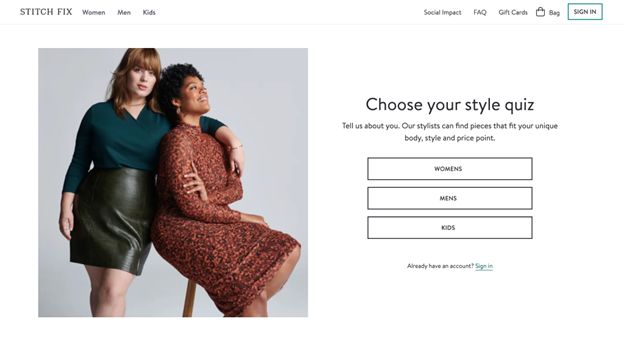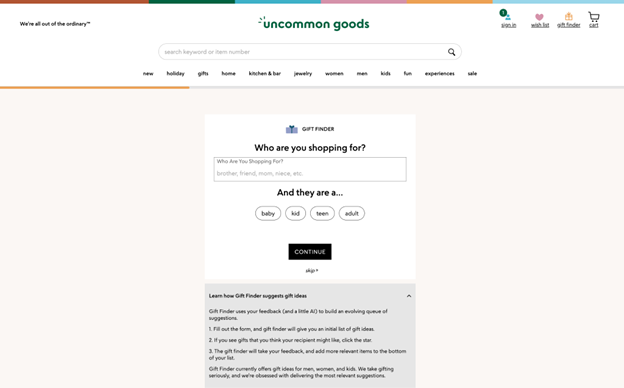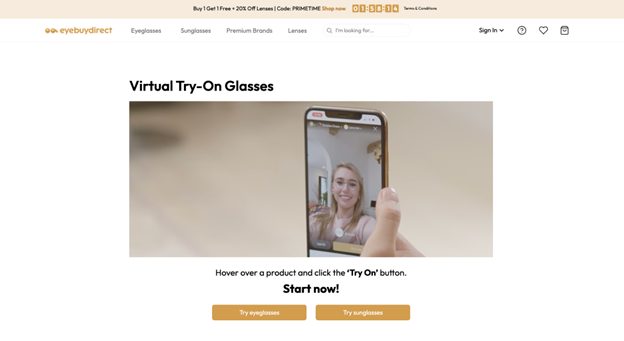To keep pace with rising consumer expectations—and simplify the increasingly complex customer journey—ecommerce brands must use data analytics to create hyper-personalized experiences.
Enter guided shopping, a customer-centric strategy to present online shoppers with products tailored to their needs.
In this post, we’ll explore the increasing relevance of guided shopping in ecommerce, along with how it works to improve customer experience, increase conversion rates, and shorten the time it takes to make buying decisions.
What is Guided Shopping?
Guided shopping refers to providing shoppers with assistance, advice, and direction throughout their shopping journey. In ecommerce, we use automated systems and data-driven insights to offer personalized product recommendations, much like an in-store salesperson would. This guides shoppers to make confident purchases in your online store. After all, as Peter Drucker said — the aim of marketing is to know and understand the customer so well the product or service fits him and sells itself.
Similarly, AI-guided selling helps consumers find what they are looking for and avoid choice paralysis that often hurts ecommerce conversion rates. With a focus on driving sales and increasing revenue, guided selling tactics subtly guide customers towards purchasing specific products or services that best fit their needs.
Consider this common scenario:
A customer is on the hunt for a new pair of sneakers for their first marathon race.
They find an ecommerce retailer via a Google search ad and click through to the website.
Once they enter, they search “marathon shoes”.
But here is where it gets tricky.
The running shoe category page they land on is home to an overwhelming array of choices. The shopper must now navigate through filters such as: ‘Agile & Flexible’, ‘Cushioned & Supportive’, ‘Springy & Neutral’, ‘Fast & Light’, all while considering the support level—’Elevated’ or ‘Neutral’.
Frustrated with too many choices and not enough guidance, the customer leaves the site. Sound familiar? With a guided shopping solution, the ecommerce retailer could have usedcollected data—like the customer’s exact search query—to present specific products, optimized for their explicit need.
Authentic Personalization: The Future of Ecommerce
Today’s consumers expect personalized shopping experiences.
56% of people say they will become repeat buyers after a personalized shopping experience, a 7% increase year-over-year in 2023. Another 71% expect companies to deliver personalized interactions, and 76% report feeling frustrated when companies do not deliver on that promise.
A whopping 58% of smartphone users feel more favorable toward brands whose mobile sites or apps remember who they are and their behavior.
But personalization must go beyond browsing history-based recommendations. Rather than rely on past behavior, consumers would prefer that ecommerce brands take the time to understand their unique needs and preferences—22% of customers will even gladly share their data in return.
In other words, the future of ecommerce is authentic personalization, or highly contextualized personalization derived from numerous touchpoints throughout each shopper’s customer journey.
Authentic personalization helps limit customer fallout rates at each stage of the customer journey, subtly directing customers to the products they need while enhancing convenience each step of the way. In return, one-time shoppers are more likely to become loyal customers and repeat buyers.
80% of consumers are more likely to make a purchase when brands offer personalized experiences”
Real-World Examples of Guided Shopping
Take a look at real-world ecommerce guided shopping examples.
Interactive Quizzes
Interactive quizzes are a staple in ecommerce marketing strategies to help steer consumers toward more confident purchase decisions. In recent years quizzes have become an integral component of a complete guided shopping approach, often receiving designated pages on ecommerce websites.
An interactive quiz is structured as a simple set of questions, often presented on the screen one at a time, with a progress bar to indicate the number of questions left. Questions typically include images or videos alongside each answer to represent a product category or specific product variant.
By walking an online shopper through an interactive quiz one question at a time, an ecommerce retailer can glean several pieces of information. For instance, it can discern the number of shoppers looking for a certain product category or identify the less popular products on the site.
Interactive quizzes help involve buyers in the product discovery process, opening their eyes to tons of unexplored categories. There’s also an inherent gamification aspect of quizzes, of which 60% of consumers say they’re more likely to buy from a brand if they enjoyed playing a game with it.

A popular interactive quiz in the ecommerce space belongs to Stitch Fix, a digital personal styling subscription service that uses recommendation algorithms to tailor clothing suggestions based on budget, size, and style. The quiz plays an integral role in persuading buyers to begin a subscription.
Product Finders
Product finders are similar to interactive quizzes but without the gamification elements.
True to their name, product finders help customers narrow down their choices once they’ve begun browsing on an ecommerce website. Like quizzes, product finders use questions to guide online shoppers toward the products they need. In some cases, it might be some they didn’t know existed.
This is especially true for consumers who leverage product finders to locate gift ideas for friends and family or to pinpoint a personal splurge purchase. Often in heavy rotation during the holiday season, ecommerce brands launch product finders specifically to assist in finding new, fun items.

A fantastic product finder for gifts is the aptly named Uncommon Goods Gift Finder. All shoppers do is fill out a brief prompt of who they are shopping for and click the star next to any relevant gift ideas that populate. The more a user ‘stars’ items, the more relevant ones are added to the list.
Guided Shopping Strategy
Guided shopping heavily relies on technology, whether it’s AI-driven analytics or AI-powered assistants. Here are some of the most essential elements ecommerce brands should keep in mind when creatinga dedicated guided shopping strategy.
Customer Segmentation
Customer segmentation is integral for delivering tailored messages to the correct audiences, but it’s not possible without thorough data. However, it’s no secret that recent concerns surrounding customer data privacy and rising consumer wariness over data security can make that difficult.
In response to heightened data privacy concerns, ecommerce brands are increasingly relying on zero-party data. As per a recent survey, 78% of business leaders consider first-party data, including purchase history and website behavior, to be the most valuable source of data for personalization.
Nevertheless, forward looking ecommerce brands would argue that you need to take data privacy and personalization one step further — with zero-party data.
Here is a breakdown of the differences:
- Zero-party data is willingly and intentionally shared by a customer with a brand. It ranges from preference center data to purchase intentions, such as indicated size and style.
- First-party data is collected from customers when they interact with a business website, engage with a brand’s marketing materials, or make a purchase through the brand.
- Third-party data is gathered by a data provider from several business websites and applications that have no direct relationship with the customer or the online brand.
Understand Your Customers
Your customers are far more than just their demographics, like their age or location. The era of authentic personalization demands more specific customer data that enables ecommerce brands to better understand their customers.
Online experiences that collect zero-party data directly from shoppers can help you capture this data. For ecommerce brands, collecting zero-party data can be as simple as implementing a rewards program or an account system on the site for customers to input details like preferences and popular purchases.
Create Urgency and Scarcity
You can guide a customer to the product they want—or need—but you can’t necessarily force them to purchase it. To encourage more conversions, create a sense of urgency and scarcity for shoppers.
Often referred to as ‘fear of missing out’ or ‘FOMO’ marketing, urgent messaging motivates shoppers to take action. Ecommerce retailers can utilize limited-time promotions on previously viewed items or send push alerts that an item in the cart is in low stock to prompt a customer to make a purchase.
See how better data, better experiences and better intelligence drives better outcomes every time.
The Mechanisms Behind Guided Shopping
Guided shopping is made possible by creating online experiences that interact and engage with your customers. By asking specific questions about their needs, you collect zero-party data. AI and advanced machine learning tools process and use this information in real-time to adapt and personalize the user experience.
9 in 10 brands trust AI-powered personalization to drive business growth and nearly 70% are increasing their investment in 2024.
From here, ecommerce brands can automate guided shopping at scale to deliver buyers tailored product recommendations and shopping experiences in real-time.
There are several guided selling tools on the market today, such as Zoovu, that streamline the personalization process with no-code, AI-powered assistants. These tools work in conjunction with data analytics to instantly adapt product recommendations.
Beginning from the start of the customer journey, AI-guided shopping mechanics will:
- Enable hyper-personalized advertising. Data-driven insights help brands maintain accurate customer profiles and precisely segment audiences for targeted advertisements.
- Inform unique landing pages, dynamic pricing, and promotions. AI algorithms utilize past visits and cues on where site sessions are originating from to craft relevant offers.
- Orchestrate omnichannel retargeting campaigns. AI technology can reuse in-session data to implement a guided shopping strategy at crucial touchpoints, like email and ads.
Benefits of Implementing Guided Shopping
At a time when ecommerce brands risk losing 38% of their existing customer base due to poor personalization efforts, guided shopping solutions help ensure that consumer data is used not just properly, but profitably. Consider the benefits of implementing guiding shopping for ecommerce.
Boost Order Values and Limit Cart Abandonment.
The primary benefit of implementing guided shopping is providing authentic personalized experiences for online shoppers. As per a recent Deloitte study, 80% of consumers are more likely to do business with brands that personalize their experiences, especially with relevant offers.
Even better, the introduction of guided shopping helps with targeted upselling to increase a retailer’s average order value (AOV). By understanding customer preferences, guided shopping can strategically upsell products that encourage consumers to spend 38% more on average.
Likewise, guided shopping works to effectively reduce cart abandonment rates, a metric that can torpedo ecommerce performance. Given the sheer volume of products available on an ecommerce site, guide shopping minimizes confusion and decision fatigue, limiting overall cart abandonment.
Enhanced Data Collection and Marketing Efficiency
Guided shopping relies on advanced AI algorithms and automation that collect a vast assortment of consumer data. Instead of allowing these insights to sit in silos, a guided shopping strategy involves collecting and analyzing customer data for future strategies, such as inventory or marketing plans.
Rather than attempt to predict broad purchase trends, ecommerce retailers that harness AI-driven guided shopping tools identify consumer shifts in product interest in real time. AI helps cut back on the time spent manually assessing trends and pinpoints areas where sales efforts are most effective.
The wealth of insights derived from guided shopping tools can also enhance marketing efficiency for ecommerce brands. AI-powered tools segment audiences for targeted advertisements, which can deliver up to eight times the marketing return on investment (ROI) and lift sales by at least 10%.
Improved Brand Loyalty and Fewer Order Returns
Consumer loyalty is priceless, and guided shopping tools help move that needle in an ecommerce brand’s favor. These tools ensure that customers easily find and buy products that solve their specific problems, making them happy and satisfied with their purchase. This not only strengthens their bond with the brand but also promotes enduring loyalty and positive word-of-mouth.
The more a consumer feels catered to, the more likely they are to be satisfied with their shopping experience—satisfied enough to become repeat customers. When an ecommerce brand can provide a convenient shopping experience, it generates a higher customer lifetime value (CLV). Best yet, AI-driven guided shopping directs customers to products based on their particular needs, thus increasing their confidence in purchase decisions and lessening the chance of returns. Being that the total value of online returns is a whopping $212 billion, this is a major benefit for brands.
Looking to experience the benefits of guided shopping?
Future Trends in Guided Shopping
Guided shopping is far from a fad. In the coming years, ecommerce retailers can expect technology innovations to further influence online shoppers’ preferences and purchase behavior.
Voice-Activated Shopping Assistants
Voice-activated assistants make it increasingly easy for consumers to purchase products with simple voice commands. In fact, research shows that voice shopping sales skyrocketed to almost $40 billion by the end of 2022, compared to just $2 billion a few short years ago in 2018.
Today’s consumers already take advantage of the potential of voice-activated shopping assistants. Approximately 60% of American online shoppers make weekly and even daily purchases via voice-activated assistants, such as Amazon Echo, Google Home, and Samsung SmartThings.
Items purchased through voice-activated shopping assistants range from household necessities, such as hand soap and toilet paper, to food and beverage items. Though ecommerce brands have yet to strike specific partnerships, certain restaurant chains have already ironed out collaborations.

For instance, Domino’s Anywhere is a campaign powered by the Domino’s Pizza chain and various voice-activated assistants to enable hands-free ordering. Domino’s customers can place a new order with Domino’s Skill for Amazon Alexa or Domino’s app on Apple CarPlay and Apple Watch.
Virtual Try-Ons
While artificial intelligence and machine learning are largely behind advancements in voice-activated shopping assistants, virtual try-ons are a bit different. Powered by augmented reality (AR), virtual try-ons help directly engage shoppers in the purchase process.
VR-powered virtual try-ons exploded in popularity throughout the COVID-19 pandemic, largely due in part to local restrictions as well as customers’ desire to access contactless shopping experiences.
Today, a whopping 57% of U.S. shoppers agree that virtual or augmented reality experiences would encourage them to make purchases. Fortunately, modern consumers can find virtual try-on services as guided shopping tools throughout a variety of ecommerce retailers across product categories.

For instance, EyeBuyDirect offers a virtual try-on service for both eyeglasses and sunglasses. Users simply enable camera access to begin the virtual try-on feature. For customers with poor eyesight, users can also record a short video of themselves and try the glasses on in the recorded video.
***
Guided shopping isn’t a fad. It is where online shopping is headed. The brands that truly get this and make shopping feel more like a heart-to-heart chat than a transaction will reap the rewards.
If you are looking for a way to do this at scale, check out a product discovery platform, like Zoovu. Request a demo.

